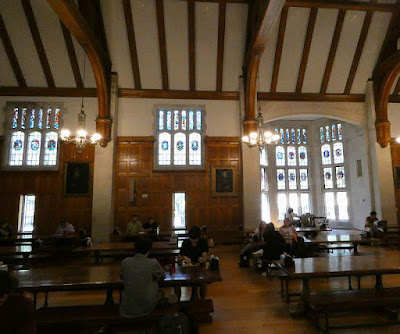Paul Manship. Indian Hunter and Pronghorn Antelope. Gambier O. 1917, poured 2001.
Another one is outside Museum of Fine Arts, Boston. This work has two figures separated in space, and in action. The moment in time depicted is after the bowman shoots his arrow into the flesh of his prey.
The arrow is visible in its strike.
This was also cast and poured many years after the artist's death. Since the figures are nekkid, some people were piqued. Currently, Kenyon College is commemorating their 200th year since founding. Kenyon was the first private college in Ohio. It was meant to educate the Episcopal clergy. There is not a seminary there now. For some time it was the seat of the Ohio Episcopal Protestant diocese. There is a museum for contemporary art on campus, and several outdoor sculptures.
Charles J. Connick made stained glass windows for the grand dining hall on Kenyon's campus in 1928. He also produced a multi-scened doubled lintel window in the church, and two multi-scened windows in the tower of Peirce Hall, which has the dining room.
Connick has many windows looking down on students eating. Some are triples, some more. Connick himself was well read, and wrote well himself. Each window has medallions of American and British writers, and their works. Some windows have quotations, some have additional figures away from the central point of interest. This one includes Melville's Moby, and Thoreau's Walden. Some students have wanted to read all the works portrayed.
Charles J. Connick made stained glass windows for the grand dining hall on Kenyon's campus in 1928. He also produced a multi-scened doubled lintel window in the church, and two multi-scened windows in the tower of Peirce Hall, which has the dining room.
Connick has many windows looking down on students eating. Some are triples, some more. Connick himself was well read, and wrote well himself. Each window has medallions of American and British writers, and their works. Some windows have quotations, some have additional figures away from the central point of interest. This one includes Melville's Moby, and Thoreau's Walden. Some students have wanted to read all the works portrayed.
Charles J. Connick. The Merchant of Venice. 1928.
There are a few of Shakespeare's plays. The Merchant of Venice has the Scales of Justice above it.









No comments:
Post a Comment